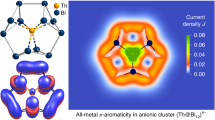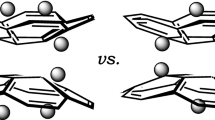Abstract
An abrupt change in internuclear Re–Re distances between {Re6} subunits in the carbon-centered [Re12μ6-CS17(CN)6]n−complexes caused by the change of the oxidation state (n = 6, 8) is first theoretically shown to be possibly controlled by an external electric field.13C NMR signal is shown to change over ~400 ppm (~37G) for μ6-C atom together withn. Thereby, the metal cluster [Re12μ6-CS17(CN)6]n−can be considered as a perspective model of a molecular switch.
Similar content being viewed by others
Introduction
Molecular electronics has been a subject of growing interest in recent years [1]. As was shown, a monoelectronic transistor can be constructed on the basis of a single p-phenylenevinylene oligomer that can have a varied oxidation state and is composed of five benzene rings connected by four double bonds [2]. Great opportunities are also associated with metal cluster complexes used as a basis for various nanodevices and molecular motors [3]. Metal cluster compounds are perspective elements of synthetic metals including superconductors. Some of them (e.g., Chevrel phases [4–6]) are characterized by high parameters of critical magnetic fields of superconductivity reaching 60 T. Structurally, the phases are characterized by metal bonds being formed between triangular faces of the neighboring octahedral units.
Recent research reported 12-rhenium cluster complexes [Re12CS17(CN)6n− (n = 6, 8) with a unique crystal structure and a reversible redox two-electron transformation {[Re12CS17(CN)66−↔[Re12CS17(CN)68−} [7]. The complexes are dimers composed of two Re6 octahedrons connected by rhenium atoms through the interstitial carbon with a trigonal-prismatic coordination, {Re3(μ6-C)Re3}, and by three bridging sulfur atoms μ2-S with corner coordination of rhenium atoms, {Re(μ2-S)Re}. According to X-ray data, the change in the oxidation state of the complex is accompanied by substantial changes in internuclear distances (Rein – Rein ~ 0.3 Å) between two metal subunits {Re6}, whereas inside {Re6} subunits interatomic distances Re–Re do not change more than for 0.01 Å (Fig. 1). In other words, the two subunits {Re6} are closer to each other in [Re12CS17(CN)66− than in [Re12CS17(CN)68−.
As is well known, a nanoscale device can be constructed from a molecule only if the molecule exhibits such electronic effects as rectification [8], amplification [9] or switching [10, 11]. Here, we study electronic effects in complexes [Re12CS17(CN)6n− (n = 6, 8) by NMR spectroscopy and quantum chemical method of electron localization function (ELF) [12, 13] and consider the effects as an evidence of molecular switching.
Experimental Procedure
13C NMR spectra were measured from the polycrystalline samples K8Re12CS17(CN)6 20H2O (I) and K6Re12CS17(CN)6 (II) synthesized by precipitating [Re12CS17(CN)68−/6− complexes from solutions [7]. 13C NMR spectra of (I) and (II) enriched by 13C were measured by Avance-400 spectrometer of BRUKER Bio-Spin in an ampoule for a rotor with the outer diameter 4 mm, the sample being rotated at the magic angle (MAS) at room temperature. The rotation rate was 7, 11 and 15 kHz. The duration of the stimulating 90° pulse was 5 μs, the accumulated amount was 200. The relaxation delay was 10 s. Tetramethylsilane (tms) was used as an external standard for the scale of chemical shifts.
Computational Details
Quantum-chemical study of the electronic structure of model systems [Re12CS17(CN)6n− (n = 6, 8) was carried out by a spin-restricted DFT method (code ADF2006 [14]) with model Hamiltonians of density functionals given by the sum of a local density functional LDA (VWN [15]) and a gradient exchange functional GGA (Becke [16] and Perdew [17]). The all-electron basis set of the TZP type, as included in the ADF2006 program, was used for all atoms. Geometry optimization was performed for D3h point group; relativistic effects and spin–orbital interaction were taken into account with the zero-order relativistic approximation method ZORA [18]. 13C NMR chemical shifts were calculated by the method GIAO in view of scalar relativistic effects and spin–orbital interaction [19–21]. Interatomic interactions were studied by a quantum-chemical topological method “Electron localization function” (ELF) [13]. In this method, we analyze the function.

Dh(r) is the density of the Thomas–Fermi kinetic energy for the homogeneous electron gas, which acts as a normalizing multiplier; D(r) is interpreted as excess density of the local kinetic energy of electrons (fermions) resulting from repulsion according to the Pauli principle relative to the density of the local kinetic energy of bosons [22]. The ELF is assumed to approximately 1 in the regions of space that are typical of the maximum localization of electron pairs with antiparallel spins (colored blue in our drawings). The ELF is 0.5 in the regions where the electron density is close to that of the homogeneous electron gas (green) and ~0 in the regions with delocalized electrons (red).
Results and Discussion
It was found out that both structure and 13C NMR spectra change dramatically depending on the oxidation state (n) of the complex [Re12CS17(CN)6n− (Fig. 2). According to the obtained data, the reduction/oxidation of the complex [Re12CS17(CN)6n− is accompanied by the change of 13C NMR signal from μ6-C for 415 ppm (or ~37G) that substantially exceeds chemical shifts due to the change of the distances between carbon–transition metal [23]. Besides, there is obviously a fundamental difference between the electrically conductive properties of the complexes since the chemical shift is caused by induced electric currents to arise in the complexes in an external magnetic field [24].
Quantum-chemical DFT calculations show a good agreement with the data of X-ray-structural analysis [7, 25] and NMR data (Table 1). The fact suggests a high reliability of the model of electronic structure of complexes [Re12CS17(CN)6n− (n = 6, 8) received at the DFT level.
The energy gaps between the highest occupied and the lowest unoccupied molecular orbitals (HOMO-LUMO gap) are 1.05 eV (n = 6) and 1.31 eV (n = 8), respectively [25]. The difference between the energy gaps and distance between the two subunits {Re6} also suggests different resistance of the molecular complexes [26]. Note that according to Kozlova et al. [25], HOMO orbital is characterized by some bonding interaction between Re atoms from different subunits {Re6} in the complex [Re12CS17(CN)66− and by antibonding interaction in [Re12CS17(CN)68−.
The study of the electronic density by the method of electron localization function (ELF) revealed weak exchange interactions (ELF ~ 0.3) between μ6-C and μ2-S in the complex [Re12CS17(CN)66−, the interaction almost disappears in the complex [Re12CS17(CN)68−[25]. The interaction can affect the structural properties, since even weak localization of electron pairs with antiparallel spins between two positively charged Re atoms should result in some reduction of the distances between subunits {Re6}. Therefore, the internuclear distances Rein – Rein can be changed if we somehow succeed to weaken or strengthen this interaction.
We placed hypothetical point chargesQ in the plane {(μ6-C) − (μ2-S)3} at the distance ~5 Å from μ2-S atoms of [Re12CS17(CN)6]8−complex (Fig. 3) and calculated ELF distribution maps. Various chargesQ and their various positions around [Re12CS17(CN)6]8−complex were tried. The most demonstrative impact of the external electric field was seen forQ = ±25e. The modeled point chargeQ = ±25e creates on the μ2-S atom an electrostatic potential ~10−9 V which is 10–100 times higher than typical an electrostatic potentials created by the atoms inside the complexes. As can be seen, the electrostatic field of a point charge (especially, a negative charge) reinforces the exchange interaction between μ6-C and μ2-S atoms. As mentioned earlier, [Re12CS17(CN)6]6−is characterized by increased exchange interaction between μ6-C and (μ2-S)3. Therefore, the magnification of exchange interaction between μ6-C and (μ2-S)3in the complex [Re12CS17(CN)6]8−should result in its ionization and reduction in the distances between {Re6} subunits. In fact, the increased localization of electronic lone pairs observed at the sulfur atoms in the positions μ3-Sup(Q = −25e) and μ2-S (Q = +25e) can signify the beginning of the oxidation process ([Re12CS17(CN)6]8−→[Re12CS17(CN)6]6−) (Fig. 4).
Conclusions
Thereby, the oxidation state and the distances between {Re6} subunits in the [Re12CS17(CN)6]8−complexes and, therefore, the electron properties of the system are shown to be controlled by an external electric field. We believe that the ON condition with higher conductivity corresponds to the complex [Re12CS17(CN)6]6−, since NMR spectroscopy reveals the strongest paramagnetic currents induced by external magnetic field. The state can be achieved by applying external electric field in the plane containing three atoms μ2-S and the atom μ6-C of the complex [Re12CS17(CN)6]8−. Similarly, OFF state should result from turning off the field. We believe that the system is an example of a monomolecular switch.
References
Petty MC, Bryce MR, Bloor D (Eds): Introduction to molecular electronics. Oxford University Press, New York; 1995.
Kubatkin S, Danilov A, Hjort M, Corlil J, Bredas J-L, Stuhr-Hansen N, Hedegard P, Bjornholm T: Nature. 2003, 425: 698. COI number [1:CAS:528:DC%2BD3sXotV2iu78%3D]; Bibcode number [2003Natur.425..698K] 10.1038/nature02010
Champin B, Mobian P, Sauvage J-P: Chem. Soc. Rev.. 2007, 36: 358. COI number [1:CAS:528:DC%2BD2sXhtVKlur8%3D] 10.1039/b604484k
Chevrel R, Sergent M, Prigent J: J. Solid. State. Chem.. 1971, 3: 515. COI number [1:CAS:528:DyaE3MXlsFGlu7Y%3D]; Bibcode number [1971JSSCh...3..515C] 10.1016/0022-4596(71)90095-8
Fisher O, Maple MB (Eds): Superconductivity in ternary compounds I. Structural electronic and lattice properties. Springer, Berlin; 1982.
Fisher O, Maple MB (Eds): Superconductivity in ternary compounds II. Superconductivity and magnetism. Springer, Berlin; 1982.
Mironov YV, Naumov NG, Kozlova SG, Kim SJ, Fedorov VE: Angew. Chem. Int. Ed.. 2005, 44: 6867. COI number [1:CAS:528:DC%2BD2MXht1amu7fK] 10.1002/anie.200501911
Aviram A, Ratner MA: Chem. Phys. Lett.. 1974, 29: 277–283. COI number [1:CAS:528:DyaE2MXhs1Cjtbw%3D]; Bibcode number [1974CPL....29..277A] 10.1016/0009-2614(74)85031-1
Joachim C, Gimzewski JK, Tang H: Phys. Rev. B.. 1998, 58: 16407. COI number [1:CAS:528:DyaK1cXotVentrc%3D]; Bibcode number [1998PhRvB..5816407J] 10.1103/PhysRevB.58.16407
Aviram A, Joachim C, Pomerantz M: Chem. Phys. Lett.. 1988, 146: 490–495. COI number [1:CAS:528:DyaL1MXjvVGntg%3D%3D]; Bibcode number [1988CPL...146..490A] 10.1016/0009-2614(88)87486-4
Moresco F, Meyer G, Rieder K-H: Phys. Rev. Lett.. 2001,86(4):672. COI number [1:CAS:528:DC%2BD3MXltlWkug%3D%3D]; Bibcode number [2001PhRvL..86..672M] 10.1103/PhysRevLett.86.672
Becke AD, Edgecombe KE: J. Chem. Phys.. 1990, 92: 5387. Bibcode number [1990JChPh..92.5397B]
Savin A, Jepsen O, Flad J, Andersen OK, Preuss H, von Schnering HG: Angew. Chem. Int. Ed. Engl.. 1992, 31: 187. 10.1002/anie.199201871
Amsterdam Density Functional (ADF) program Release 2006.02. (Vrije Universteit: Amsterdam, The Netherlands, 2006)
Vosko SH, Wilk L, Nusair M: Can. J. Phys.. 1980, 58: 1200. COI number [1:CAS:528:DyaL3cXlvFagt74%3D]; Bibcode number [1980CaJPh..58.1200V] 10.1139/p80-159
Becke AD: Phys. Rev. A.. 1988, 38: 3098. COI number [1:CAS:528:DyaL1cXmtlOhsLo%3D]; Bibcode number [1988PhRvA..38.3098B] 10.1103/PhysRevA.38.3098
Perdew JP: Phys. Rev. B.. 1986,33(12):8822. Bibcode number [1986PhRvB..33.8822P] 10.1103/PhysRevB.33.8822
Van Lenthe E, Ehlers AE, Baerends EJ: J. Chem. Phys.. 1999, 110: 8943. Bibcode number [1999JChPh.110.8943V] 10.1063/1.478813
Schreckenbach G, Ziegler T: J. Phys. Chem.. 1995, 99: 606. COI number [1:CAS:528:DyaK2MXivVeqsbc%3D] 10.1021/j100002a024
Schreckenbach G, Ziegler T: Int. J. Quantum. Chem.. 1997, 61: 899. COI number [1:CAS:528:DyaK2sXhtVyjtb0%3D] 10.1002/(SICI)1097-461X(1997)61:6<899::AID-QUA3>3.0.CO;2-R
Wolff SK, Ziegler T: J. Chem. Phys.. 1998, 109: 895. COI number [1:CAS:528:DyaK1cXktlOgu7c%3D]; Bibcode number [1998JChPh.109..895W] 10.1063/1.476630
Savin A, Jepsen O, Flad J: Angew. Chem.. 1992, 31: 187. 10.1002/anie.199201871
23. M. Kaupp, Chem. Commun. 1141 (1996). doi:10.1039/cc9960001141
Abragam A: The principles of nuclear magnetism. Oxford University Press, Oxford; 1961.
Kozlova SG, Gabuda SP, Slepkov VA, Mironov YV, Fedorov VE: Polyhedron. 2008, 27: 3167. COI number [1:CAS:528:DC%2BD1cXhtFWmsL%2FL] 10.1016/j.poly.2008.07.007
Kushmerick JG, Holt DB, Pollack SK, Ratner MA, Yang JC, Schull TL, Naciri J, Moore MH, Shashidhar R: J. Am. Chem. Soc.. 2002, 124: 10654. COI number [1:CAS:528:DC%2BD38Xmt1Sks7s%3D] 10.1021/ja027090n
Acknowledgments
We thank D.F. Habibulin for the help in measuring the NMR spectra. The study was supported by the RFBR grants (07-03-00912 and 08-03-00826) and by the Presidium of the Russian Academy of Sciences.
Author information
Authors and Affiliations
Corresponding author
Rights and permissions
Open Access This article is distributed under the terms of the Creative Commons Attribution 2.0 International License ( https://creativecommons.org/licenses/by/2.0 ), which permits unrestricted use, distribution, and reproduction in any medium, provided the original work is properly cited.
About this article
Cite this article
Gabuda, S., Kozlova, S., Mironov, Y.V. et al. Electronic Switch in the Carbon-Centered [Re12CS17(CN)6]n−Nanocluster. Nanoscale Res Lett 4, 1110 (2009). https://doi.org/10.1007/s11671-009-9354-2
Received:
Accepted:
Published:
DOI: https://doi.org/10.1007/s11671-009-9354-2








